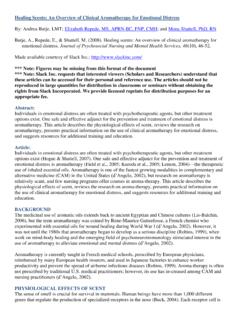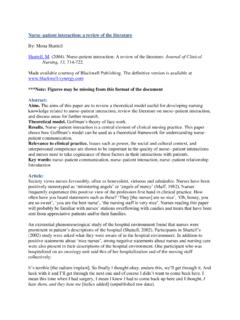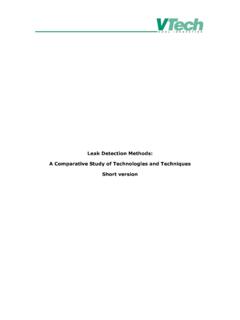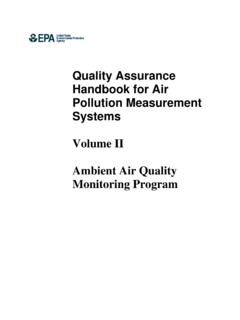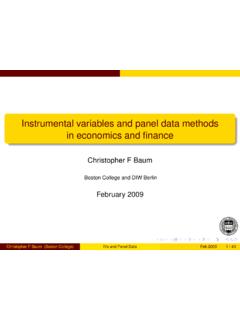Transcription of The Measurement of Self-Esteem: Refining Our Methods
1 The Measurement of self - esteem : Refining Our Methods *. By: David H. Demo Demo, David, H. (1985). The Measurement of self - esteem : Refining our Methods . Journal of Personality and Social Psychology, 48, 1490-1502. DOI: Made available courtesy of the American Psychological Association: This article may not exactly replicate the final version published in the APA journal. It is not the copy of record. **Reprinted with permission. No further reproduction is authorized without written permission from the American Psychological Association. This version of the document is not the version of record. Figures and/or pictures may be missing from this format of the document.**. Abstract: A review of the literature indicates that (a) very little attention has been devoted to Measurement problems plaguing the study of self - esteem and (b) few studies employ more than one type of self - esteem instrument. This study addresses these issues by using eight measures of self - esteem involving self -reports, ratings by others, and a projective instrument.
2 Their intercorrelations are examined to provide preliminary validational evidence; then, confirmatory factor analysis is used to construct Measurement models and further assess the validity of the measures. The results suggest that two traditional questionnaires and a personal interview are valid in measuring experienced self - esteem , and three measures involving ratings by others are valid in measuring presented self - esteem These findings are consistent with previous multidimensional conceptualizations of self - esteem , indicating that a variety of Methods is necessary to adequately measure self - concept. Article: self - esteem is a central focus of research examining human personality, and yet the conceptualization and operationalization of this variable have been both haphazard and inconclusive. There is little consensus on a definition; there is a diverse range of Measurement procedures; and, in many cases, there are weak or nonexistant correlations among indicators.
3 Hence, various findings relating to self - esteem are not comparable (Wells & Marwell, 1976; Wylie, 1974, 1979). Shavelson, Hubner, and Stanton's (1976) conclusion remains true today; that is, " self -concept research has addressed itself to substantive problems before problems of definition, Measurement , and interpretation have been resolved" (p. 410). Yet studies of the Measurement problems in self - esteem research are rare and inconsequential. A few studies examined the convergent and discriminant validity of self -report measures of self - esteem (Hamilton, 1971; Silber & Tippett, 1965; Van Tuinen & Ramanaiah, 1979); Fleming and Watts (1980) factor analyzed the Janis and Field (1959) Feelings of Inadequacy Scale;. Fleming and Courtney (1984) factor analyzed the self -Rating Scale (a revised version of the Janis & Field Scale); and Marsh, Relich, and Smith (1983) factor analyzed the self -Description Questionnaire, which is designed to measure seven dimensions of self -concept (Shavelson et al.)
4 , 1976). The current study is designed to review a variety of instruments that are intended to measure specific dimensions of self - esteem (itself a specific component of self -concept). The objectives and rationale of each measure are presented so that the validity of each can be evaluated. *. Financial support was provided by a grant from the Spencer Foundation (R. C. Savin-Williams, principal investigator). An earlier version of this article was presented at the meeting of the Southern Sociological Society, April 1982, in Memphis. The author gratefully acknowledges the contributions of Ritch C. Savin-Williams in the formulation of the ideas presented in this article. I am also thankful for the statistical assistance provided by Francis A. Richards, Jr. and Jeffrey K. Liker, and for the many constructive suggestions offered by Ronald L. Neff, Jonathan Cheek, and anonymous reviewers. Requests for reprints should be sent to David H. Demo, Department of Sociology and Anthropology, Mississippi State University, Drawer C, Mississippi State, Mississippi 39762.
5 The proper implementation of this procedure involves across-method triangulation (Denzin, 1970), so that several distinct methodologies can be tested rather than simply comparing scores derived from a few different attitude scales (which all share the survey method). Webb (1970) explained that because every data-gathering method has specific biases, "we should like to converge data from several data classes, as well as converge with multiple variants from within a single class" (p. 322). It is then necessary to compare various Measurement procedures by examining their intercorrelations. By examining convergence or equivalence among measures, one may be able to more easily compare findings across studies and thus construct a nomological network (Cronbach & Meehl, 1955; Golding, 1977) around the concept of self - esteem (Shavelson et al., 1976) . although it is cautioned that cross-method convergence can not be equated with construct validity.
6 To assess validity, it is also necessary that one carefully examine what it is one is attempting to measure. Researchers adopting the structural perspective ( , Coopersmith, 1967; Rosenberg, 1965, 1979) define self - esteem as a global positive or negative self - assessment. According to this view, self - esteem is a personality trait characterized by considerable stability from one situation to the next, even from year to year. The vast majority of self - esteem researchers thus employ one-shot questionnaires designed to measure overall or global self - esteem . Many theorists devote attention to the idea of situational variability, but available Measurement techniques preclude the possibility of assessing such changes in self -feelings. Consistent with previous research (Savin-Williams & Demo, 1983), a more processional perspective is assumed in this study. self - esteem is viewed as a fluctuating self -attitude that most often resembles a baseline or standard self -evaluation, but that also encounters situational fluctuations from this baseline as a function of changing roles, expectations, performances, responses from others, and other situational characteristics.
7 In this manner, individuals may have generally favorable attitudes toward themselves, possess self -respect, and consider themselves persons of worth, but on certain days and in particular situations they may feel better or worse about themselves than is typically the case. This idea is by no means new, dating back at least to James's (1890) simile of self - esteem rising and falling like a barometer, but the empirical Measurement of situational variations in self - feelings is rare (see Savin-Williams & Demo, 1983; Savin-William & Jaquish, 1981). Hence, this study uses multiple and repeated measures to obtain "snapshots" of an individual's self - esteem in different social situations. Over-reliance on traditional questionnaires used to measure global self - esteem has created another problem in that other dimensions of the self -concept have been neglected. Wells and Marwell's (1976) thorough review of self - concept methodologies demonstrated that all instruments have particular biases and "to the extent that self - esteem Measurement relies on a single Measurement form orthodox verbal self -ratings it will be inadequate".
8 (p. 144). One alternative is to involve participant observers and peers for the purpose of exploring a behavioral component of self - esteem (Savin-Williams & Jaquish, 1981). As traditionally conceived (Goffman, 1956; James, 1890; Rosenberg, 1979), the presented self involves a variety of planned and detailed behavioral routines that are consistent with various role requirements and situational demands, but not necessarily consistent with the actual or the desired self . Measures of presented self - esteem are scarce (Wells & Marwell, 1976), however, prompting the construction of a behavior checklist (Savin-Williams & Jaquish, 1981) with which observers can make judgments of others' self - esteem . This instrument is used in the current study, along with two other measures of the presented self : a Q-sort, completed by observers, and peer ratings. These measures are intended to provide information not normally obtained through self -reports. Because ratings by others are based on observation (formal and informal) of an individual's behavior over a period of time, these ratings may be more objective and more generalizable than are self - evaluations.
9 In addition, peers and observers may be better able to assess one's personality characteristics because individuals tend to attribute their own actions and attitudes to situational factors (Jones & Nisbett, 1971). An alternative perspective is offered by Hamilton (1971), who argued that one rationale underlying self - ratings is that they capture vital personal information unavailable to others. In this article we use ratings by others to obtain a few dozen perspectives on a given individual, which we may then compare with self -ratings to identify similarities and discrepancies. As presently conceptualized, presented self - esteem is distinct from social confidence (Fleming & Courtney, 1984; Fleming & Watts, 1980) or social self - esteem (Van Tuinen & Ramanaiah, 1979) in that the latter represent affective states of self -consciousness and shyness in social situations, whereas the former refers to a self -evaluation that one projects to others more or less intentionally.
10 Van Tuinen and Ramanaiah defined social self - esteem as "a person's sense of adequacy or worth in his [sic] social interaction with people in general" (p. 18). Presented self - esteem , in contrast, focuses on the level of self -regard communicated to others, that is, whether individuals are comfortable with themselves rather than with interactions per se. Clearly one dimension affects the other, although social self -confidence might be expected to correlate more strongly with presented self - esteem than with self -reported (or experienced) self -regard. The three studies discussed above (Fleming &. Courtney, 1984; Fleming & Watts, 1980; Van Tuinen & Ramanaiah, 1979) obtain strong correlations between social confidence and global self - esteem . The measures used in the current study are designed to focus on the relation of experienced self - esteem to presented self - esteem . Specifically, how do others rate an individual's self -regard based on observations of that individual's behavior?





